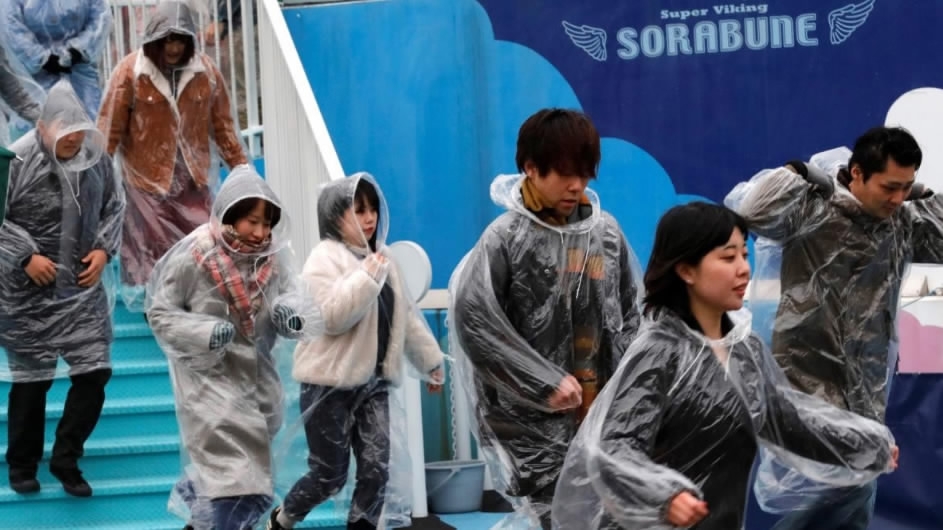
Politics
15:00, 22-Jan-2018
Tokyo holds first DPRK missile attack drill
CGTN

Tokyo held its first missile evacuation drill on Monday with volunteers taking cover in subway stations and other underground spaces that would double as shelters for the Japanese capital in the event of a missile strike from the Democratic People's Republic of Korea (DPRK).
The choreographed evacuations at a fair ground and park ringing the Tokyo Dome baseball stadium involved around 300 volunteers.
Small groups of protesters scuffled with police as they demonstrated against what they criticized as a war game that fanned public fear.

Participants walk towards a subway entrance to evacuate during a missile attack drill in Tokyo, Japan, Jan. 22, 2018. /VCG Photo
Participants walk towards a subway entrance to evacuate during a missile attack drill in Tokyo, Japan, Jan. 22, 2018. /VCG Photo
"I think it's better than nothing to have such a drill, but I am praying there is no missile attack from the North," Shota Matsushima, 20, a university student who was in a train station near the drill site, told AFP.
While hope grows that DPRK's participation in next month's Winter Olympics in the Republic of Korea (ROK) may help defuse tension in the region, Japan is escalating efforts to prepare its citizens for a possible war.
Tokyo believes the threat posed by Pyongyang's ballistic missile and nuclear weapons development is deepening.
"A missile from North Korea (DPRK) would arrive in less than 10 minutes and the first alert would come about three minutes after launch, which gives us only around five minutes to find shelter," Hiroyuku Suenaga, a Japanese government official, told volunteers after the Tokyo exercise.

A staff directs participants during an anti-missile evacuation drill at the Tokyo Dome City amusement park in Tokyo, Japan, Jan. 22, 2018. /Reuters Photo
A staff directs participants during an anti-missile evacuation drill at the Tokyo Dome City amusement park in Tokyo, Japan, Jan. 22, 2018. /Reuters Photo
Small Japanese towns and villages have conducted similar drills as the DPRK has pushed ahead with its missile and nuclear weapons programs.
Last year, Pyongyang fired three missiles over Japan and has splashed others into the sea near the country, sparking a mix of panic and outrage.
The DPRK conducted its most recent and biggest nuclear bomb test in September and has tested dozens of ballistic missiles. The latest missile test in November reached an altitude of about 4,475 kilometers (2,780 miles) and flew 950 kilometers (590 miles), passing over Japan before splashing into waters in Japan's exclusive economic zone.
Pyongyang says its weapons programs are a necessary defense against a possible US invasion.
Every time DPRK launches a missile over Japan, the nation's alert system warns residents via mobile phones and street side loudspeaker broadcasts. But many people say that such a system is useless, with too little time to evacuate and few facilities in place to survive a nuclear attack.
Amid public concern over the possibility of more missile launches, Japanese public broadcaster NHK issued a false launch alarm urging people to take shelter six days ago. That came days after a similar false alert caused panic across Hawaii.

Japan's public broadcaster NHK's false alarm about a DPRK missile launch which was received on a smart phone is pictured in Tokyo, Japan, Jan. 16, 2018. /Reuters Photo
Japan's public broadcaster NHK's false alarm about a DPRK missile launch which was received on a smart phone is pictured in Tokyo, Japan, Jan. 16, 2018. /Reuters Photo
"I am not that worried about North Korea (DPRK), if something happened that would be frightening," said Hidenobu Kondo, one of the volunteer evacuees.
However, the 50-year-old company employee said the drill would not be of much use in the event of real attack. "If I was at work it might be easy to evacuate, but If I was outside somewhere it would be more difficult," Kondo said.
Japan's defenses against a ballistic missile strike include Aegis destroyers in the Sea of Japan armed with interceptor missiles designed to destroy warheads in space.
PAC-3 Patriot missile batteries represent a last line of defense against warheads that can plunge to their targets at several kilometers per second.
Japan has also decided to buy two land-based Aegis batteries and cruise missiles.
2105km
Source(s): AFP
,Reuters

SITEMAP
Copyright © 2018 CGTN. Beijing ICP prepared NO.16065310-3
Copyright © 2018 CGTN. Beijing ICP prepared NO.16065310-3